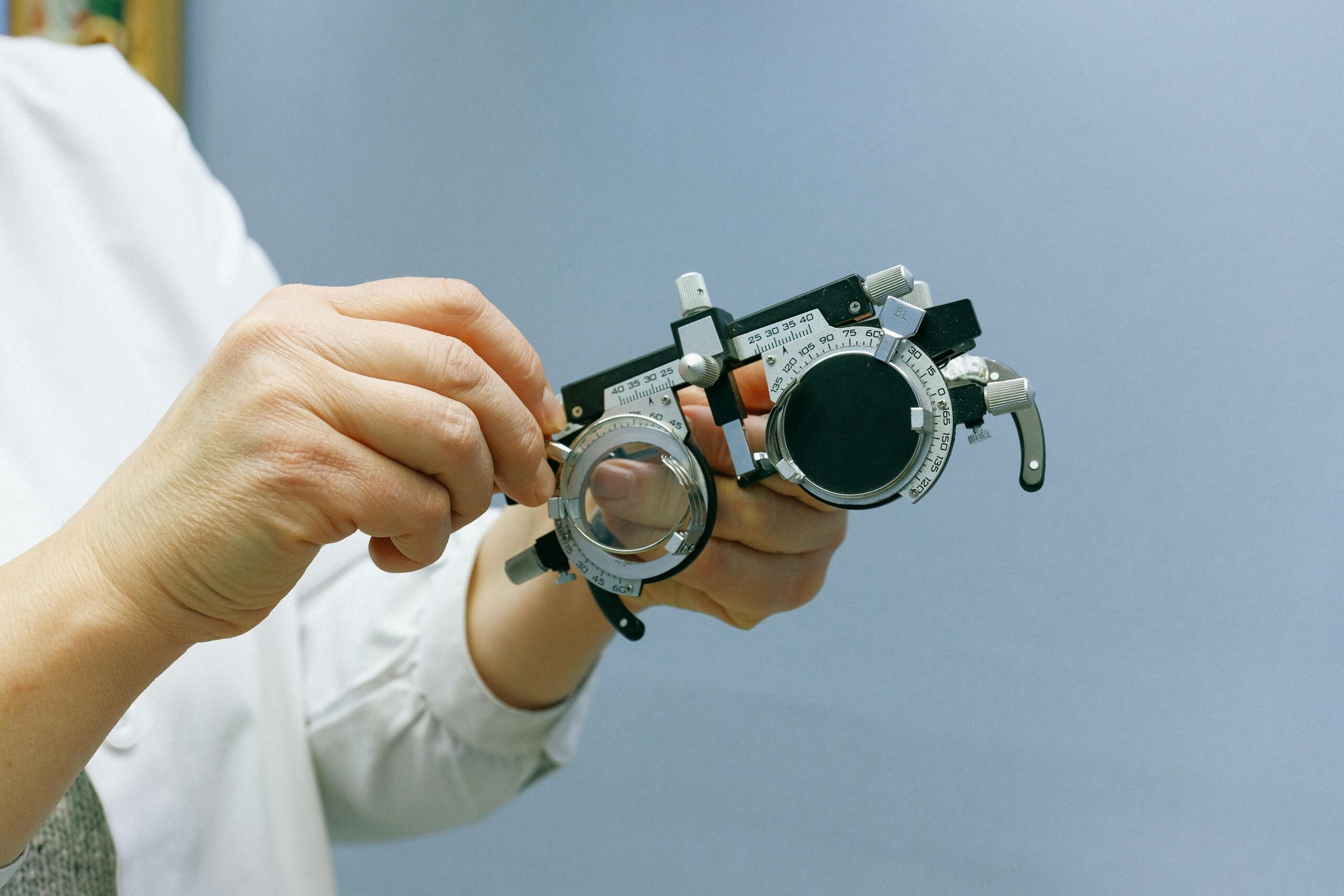Strabismus, commonly known as “crossed eyes,” is a condition in which the eyes do not align properly. While one eye may look straight ahead, the other eye may turn inward, outward, upward, or downward. This misalignment can be constant or intermittent, and it often leads to issues with depth perception and binocular vision. Strabismus can occur at any age but is most commonly observed in young children.
What Is Strabismus?
Strabismus occurs when the muscles controlling eye movement are not working together effectively, causing the eyes to point in different directions. Normally, the brain coordinates the movement of both eyes so they focus on the same point. In strabismus, however, the brain may receive two different images, which can lead to double vision or the brain ignoring the image from the misaligned eye, a condition known as amblyopia or “lazy eye.”
Types of Strabismus
Strabismus can be classified based on the direction in which the misaligned eye turns:
- Esotropia:
- Inward Turning: The eye turns inward toward the nose. Esotropia is the most common type of strabismus in infants and young children.
- Congenital Esotropia: Often present at birth or develops within the first six months of life.
- Accommodative Esotropia: Develops in children who are farsighted, as they try to focus on near objects.
- Exotropia:
- Outward Turning: The eye turns outward, away from the nose. Exotropia often occurs when a person is focusing on distant objects.
- Intermittent Exotropia: The eye may only drift outward occasionally, especially when tired, sick, or daydreaming.
- Hypertropia:
- Upward Turning: The eye turns upward, often caused by a weakness in the muscles that control eye movement.
- Hypotropia:
- Downward Turning: The eye turns downward, which is less common and may be related to issues with the extraocular muscles.
- Alternating Strabismus:
- Switching Between Eyes: In some cases, the misalignment may alternate between the two eyes, meaning that either eye may turn inward, outward, upward, or downward at different times.
Causes of Strabismus
Strabismus can have various causes, including:
- Genetics:
- Family History: A family history of strabismus increases the likelihood of developing the condition.
- Muscle Imbalance:
- Extraocular Muscle Dysfunction: When the muscles that control eye movement are imbalanced or improperly coordinated, strabismus can occur.
- Refractive Errors:
- Farsightedness: Children with significant farsightedness may develop accommodative esotropia as they strain to focus on close objects.
- Neurological Conditions:
- Brain or Nerve Damage: Conditions affecting the brain, nerves, or eye muscles, such as cerebral palsy, Down syndrome, or brain injuries, can lead to strabismus.
- Trauma:
- Eye or Head Injuries: Trauma to the eye or head can damage the muscles or nerves that control eye movement, resulting in strabismus.
- Medical Conditions:
- Thyroid Eye Disease: Conditions like thyroid eye disease can cause inflammation and swelling of the eye muscles, leading to strabismus.
- Amblyopia:
- Lazy Eye: When one eye is weaker than the other, the brain may ignore the input from the weaker eye, causing it to turn inwards or outwards.
Symptoms of Strabismus
The symptoms of strabismus can vary depending on the severity and type of misalignment:
- Misaligned Eyes: The most apparent symptom is the noticeable misalignment of the eyes, where one eye may turn in, out, up, or down.
- Double Vision: In some cases, strabismus can cause double vision (diplopia) as the brain receives two different images from the eyes.
- Difficulty with Depth Perception: Strabismus can lead to poor depth perception, making it challenging to judge distances.
- Head Tilting or Turning: Individuals may tilt or turn their heads to align their eyes better or compensate for the misalignment.
- Eye Strain: Strabismus can cause eye strain, especially when focusing on close objects.
- Squinting or Closing One Eye: Some people may squint or close one eye to reduce double vision or improve focus.
Diagnosis of Strabismus
Strabismus is typically diagnosed during a comprehensive eye examination. Early detection is crucial, especially in children, to prevent complications like amblyopia. The following tests may be used to diagnose strabismus:
- Visual Acuity Test: Measures how well each eye sees and checks for any refractive errors.
- Cover Test: Determines how well the eyes work together and identifies any misalignment.
- Ocular Motility Test: Assesses the movement of the eyes to check for muscle imbalance.
- Refraction Test: Identifies the presence of any refractive errors, such as farsightedness or nearsightedness.
- Dilated Eye Exam: Allows the eye care professional to examine the retina and optic nerve for any underlying issues.
Treatment Options for Strabismus
The treatment for strabismus depends on the cause, severity, and type of misalignment. Early treatment is essential to improve eye alignment and prevent vision problems. Common treatment options include:
- Glasses or Contact Lenses:
- Corrective Lenses: In cases where refractive errors contribute to strabismus, prescription glasses or contact lenses can help correct the misalignment.
- Prism Lenses:
- Specialized Lenses: Prism lenses can be prescribed to reduce double vision and help align the eyes.
- Eye Patching:
- Treating Amblyopia: If amblyopia (lazy eye) is present, patching the stronger eye can force the weaker eye to work harder, improving its function and alignment.
- Vision Therapy:
- Eye Exercises: Vision therapy involves exercises designed to improve eye coordination, focusing ability, and binocular vision. It is often used for intermittent or mild strabismus.
- Botox Injections:
- Temporary Muscle Weakening: In some cases, Botox injections may be used to weaken an overactive eye muscle temporarily, helping to align the eyes.
- Strabismus Surgery:
- Surgical Correction: In more severe cases, surgery may be necessary to adjust the length or position of the eye muscles, allowing the eyes to align properly. This is often done in children but can also be performed on adults.
- Treatment of Underlying Conditions:
- Addressing Root Causes: If strabismus is caused by an underlying medical condition, such as thyroid eye disease or a neurological disorder, treating that condition may help improve eye alignment.
Living with Strabismus
Living with strabismus can be challenging, particularly if it affects your vision or self-esteem. However, with the right treatment and support, many individuals with strabismus can achieve better eye alignment and improved vision. Here are some tips for managing strabismus:
- Regular Eye Exams: Regular check-ups with an eye care professional are essential for monitoring the condition and adjusting treatment as needed.
- Supportive Resources: Consider joining support groups or connecting with others who have strabismus to share experiences and tips.
- Educate Yourself and Others: Understanding your condition and explaining it to others can help reduce any misconceptions or stigma associated with strabismus.
Conclusion
Strabismus is a condition that affects eye alignment and can lead to vision problems if left untreated. Early diagnosis and intervention are key to managing the condition and preventing complications like amblyopia. With a range of treatment options available, including corrective lenses, vision therapy, and surgery, many individuals with strabismus can achieve better eye alignment and improved quality of life. If you or your child is showing signs of strabismus, it’s important to consult an eye care professional for a comprehensive evaluation and personalized treatment plan.
For more info, download our detailed brochure here.



